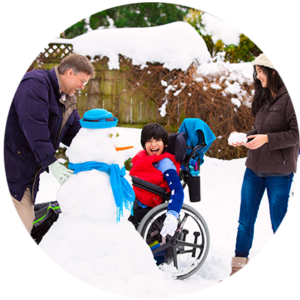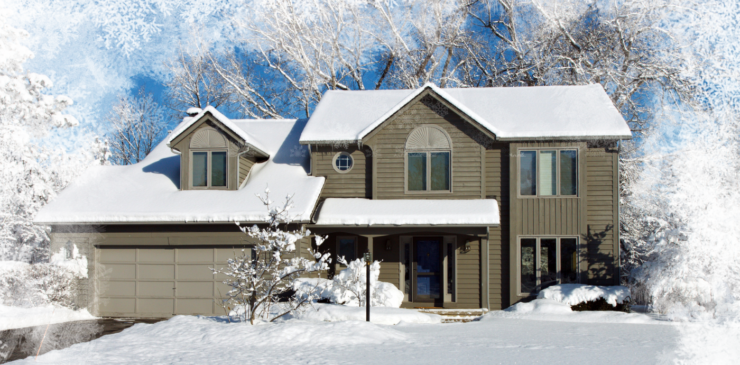The good news is that you can do many proactive things to plan for a safe and successful winter at home. Many of my clients choose to live in a house rather than a condo, and they need to deal with the many challenges that go along with it. With that in mind, I reached out to Colin Veley from Brooklin, Ontario and Tamara Gordon from Markham, Ontario, to ask for their winter tips and advice. I also reached out to Margot McWhirter, an Occupational Therapist with Inclusive Aging, to ask for her insight.
Plan Ahead: Planning is key, and Margot’s recommendations include:
- Inspect and repair any pathways and ramps leading to your house.
- Stock up on ice melter.
- Have your roof and eavestrough inspected, and clear out any leaves before freeze up.
- Install and check outdoor lighting to improve exterior visibility.
- Consider using motion sensor lights so they turn on and off automatically.
- Have your heating system serviced before it gets cold and you need it.
- Ensure radiators and air vents are not blocked and that the thermostat is in an accessible location. Many thermostats are compatible with smartphone apps for easy adjustments.
- Prepare an emergency kit in case you’re snowed in for a couple of days and/or the power goes out. Your emergency kit should include whatever you need to live safely for 48 hours.
- Set up a network of family, friends, and neighbours who can check in on you, especially during severe weather.
Entrance Solution: Ice and snow make keeping an entrance pathway open throughout the winter challenging. However, a pathway must be maintained for your safe access and also for First Responders in an emergency. If your front door is not accessible, the next best entrance option is often through the garage. This will usually require a ramp or platform lift.
 Having a garage entrance during winter is very helpful because it’s protected from the outside. It’s essential to ensure that mechanical lifts continue to work in the cold temperatures, so have them inspected in the fall. Having a backup entrance ramp is a good idea, too. Keep in mind that ice buildup along the bottom of the garage door may freeze it shut, so use an ice melter if necessary. Keep a supply on the door’s interior and exterior sides so you can get to it quickly.
Having a garage entrance during winter is very helpful because it’s protected from the outside. It’s essential to ensure that mechanical lifts continue to work in the cold temperatures, so have them inspected in the fall. Having a backup entrance ramp is a good idea, too. Keep in mind that ice buildup along the bottom of the garage door may freeze it shut, so use an ice melter if necessary. Keep a supply on the door’s interior and exterior sides so you can get to it quickly.
Snow Clearing: Check with your municipality to see if they will shovel your sidewalk. The City of Toronto clears most sidewalks throughout the City. Still, if yours isn’t plowed, there is an application that can be submitted by people with disabilities and those over 65 to request this service. Other municipalities offer a similar service. Tamara hires a contractor to clear snow at her house, and Colin likes to hire a neighbourhood kid to shovel his driveway and front entrance; he also has a neighbour who is willing to help.
Canada Post Mail Delivery: Canada Post has a Delivery Accommodation Program that helps make delivery services accessible to all. These accommodations include:
- Home delivery for those who cannot access their neighbourhood box. Packages are delivered daily, and mail is delivered weekly.
- Re-directing mail to another community box that is more accessible.
- Changing the location of your compartment within the community mailbox.
- Providing a key turner to make opening your mailbox easier.
You can apply for the Delivery Accommodation Program online at www.CanadaPost.ca or by calling 1-844-454-3009.
Grocery Delivery: Several companies offer home grocery delivery services. Most everything the grocery store sells can be delivered right to your front door. Choose your items, pick your delivery day and time slot, and pay online.
Backup Power Source: Both Tamara and Colin have backup generators. These generators will ensure they have a continuous power source during an outage. This is very important because they both rely on mechanical entrance lifts and interior lifts. Generators will also provide power to their furnace and other essential appliances.
Call The Fire Department: Colin recommends calling the Fire Department if you need help at home, for example, if you fall out of your chair or get stuck on a mechanical lift. He lives by himself (along with his dog Tyson), and there have been at least two times that he has been in trouble and had to call the Fire Department to help him. He says if you’re stuck in winter, every minute counts and the Fire Department will get to you much quicker than a friend or family member.
Garbage Pick Up: If you’re not able to place your garbage on the curb for pick up, check with your municipality to ask if they will make alternative arrangements. In the City of Toronto, you can apply to have your garbage picked up at your front or side door.
Parking Your Vehicle: A double garage is ideal in the wintertime so you can drive in and exit your vehicle while being protected by a covered roof. This helps avoid having to clear snow and ice from your vehicle and wet wheels inside the house. Tamara chooses to park her van outside, and she coordinates her winter trips when someone is available to accompany her to help clear off the vehicle.
Keep Your Phone With You: Your cell phone is a valuable lifeline in an emergency, and Colin recommends keeping it with you at all times. He knows first-hand how important that advice is. Save your emergency contacts in your phone and turn on voice commands so you can ask Siri or Alexa to dial for you.
Wintertime in Ontario can be challenging, but it can also be fun and exciting if you’re prepared. Plan ahead and enjoy the winter.
 Jeffrey Kerr
Jeffrey Kerr
RE/MAX Prime Properties Unique Group
www.AccessibleHomeFinder.com
Call / Text: 416.417.537






